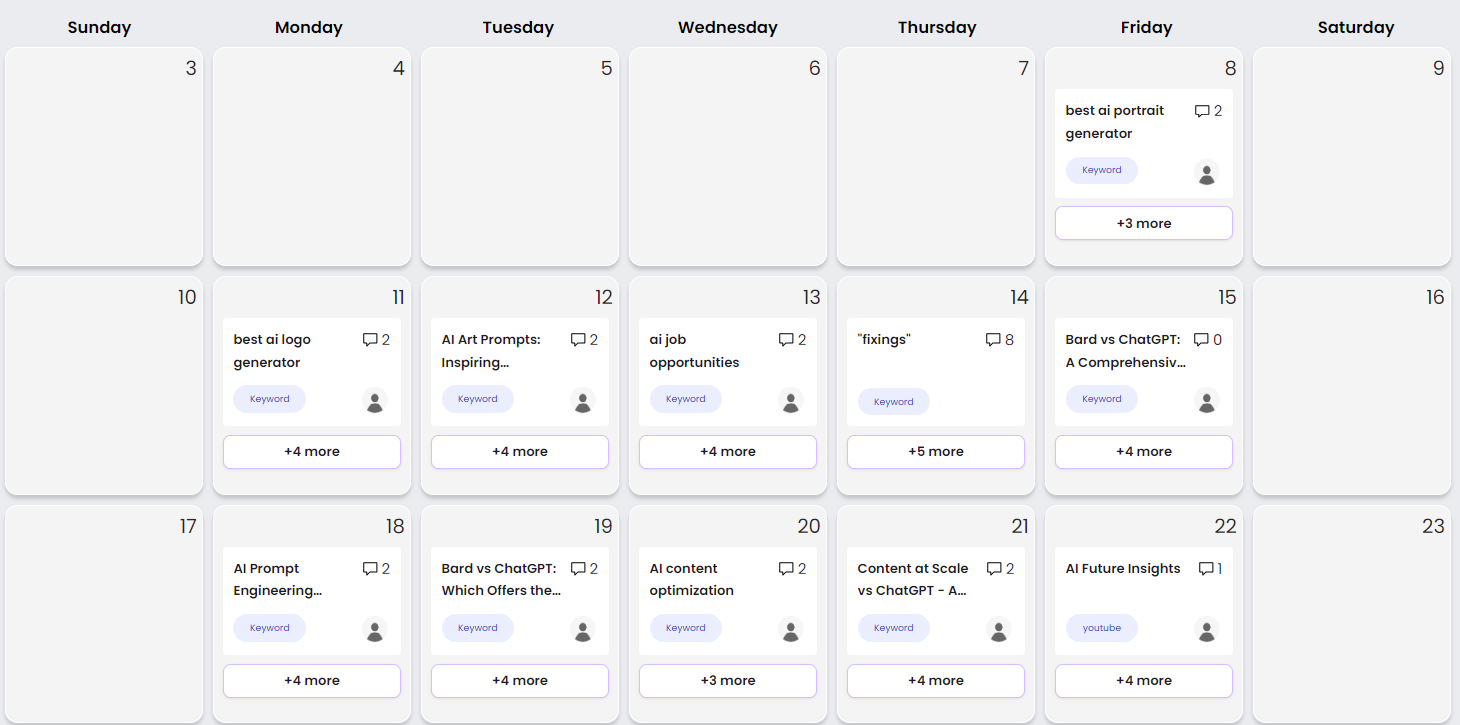Discover top guides, trends, tips and expertise from AIO Writers

Managing multiple blogs can be a challenging endeavor, particularly for those who are just starting to do this full-time. But with the right strategies and tools in place, it’s possible to run several blogs without burning out.
Why would you want to manage multiple blogs? For many bloggers, it’s all about the revenue.
While bloggers do earn $39,186 a year on average, 33% of bloggers don’t earn any money at all. One way to turn blogging into a lucrative career is to learn how to manage multiple blogs.
This post will look at how you can start multiple blogs and run them effectively while maintaining the standards you have always upheld in your main blogs.
Table of Contents
Why You Should Have Multiple Blogs
1. Diversification of Income
If you’re looking to diversify your income, launching multiple blogs is a great way to do it. By spreading your eggs across several different baskets, you can reduce the risk of relying on one source for all your income and have more stability in case something goes wrong with your main blogs.
Plus, each blog has the potential to bring in new revenue streams that you wouldn’t be able to tap into if you only had one blog.
2. Faster Growth
When you create multiple blogs, you’ll be able to enjoy faster growth because there are more opportunities for traffic and engagement than just focusing on one single topic or industry.
You can create multiple blogs that appeal to a variety of audiences and reach people who may never have found out about you if you didn’t have multi-niche blogs. This leads to more shares, backlinks, and subscribers which will help grow all your sites much faster than if they were standalone entities.
3. Reach New Audiences
When you start multiple blogs, you can reach entirely new audiences who may not have been interested in your original offering but are now drawn to your new topics. This opens up doors for collaborations with other bloggers or brands as well as SEO success through targeted keywords in certain niches or industries.
4. Develop Different Skillsets
Finally, having multiple blogs gives you the opportunity to hone your skillset beyond simply writing content.
These include marketing strategies like SEO, social media management, design and development, email list building, and affiliate marketing. All these activities require time and practice so having several projects running concurrently can help speed up the learning process while providing the valuable experience you need when scaling operations later.
How Many Blogs Can One Person Reasonably Have?
This is a common question for bloggers who wants to have multiple blogs. The answer depends on your skillset, resources, and dedication.
Time Commitment
The amount of time required to maintain separate blogs can be overwhelming. Writing posts, editing images, creating social media content, responding to comments – all these tasks take up precious time. For example, if you only can commit two hours per day to your blog writing activities, then managing 10 or more sites may prove too much of a challenge.
Resources
In addition to time management, you also need enough resources to manage blog content on different blogging platforms. These include hosting accounts, domain names, and blog automation tools. If you don’t already have access to these resources, then you need to purchase them before you begin to manage blogs – adding an extra cost to your venture.
Authority Sites vs Niche Content Websites
When deciding how many blogs you could realistically manage, it’s important to consider whether you’re building authority sites or niche content websites.
Authority sites are focused on providing comprehensive coverage across a broad range of topics while niche content websites focus solely on specific subject areas within a given industry or field of study.
Having both types of websites provides you with greater flexibility when choosing the type of blog content you want to produce and promote online.
With that said, it’s generally accepted that running more than 10 blogs at once is not feasible for most people.
Staffing
If you’re serious about wanting to manage blogs in multiple niches, it may be necessary to hire additional staff to run all your websites effectively. You might need more writers, editors, graphic designers, and social media managers.
Each role requires different skill sets that cater to the needs of multiple websites. This would require significant financial investment as well as management oversight so you shouldn’t take it lightly.
One way to cut down on your staffing expenses when running multiple blogs is by embracing full automation.
BrandWell can help you scale up your blogging efforts so you can write blogs five times faster at a quarter of the cost. The app allows you to upload a CSV file of all your keywords and it will write one 2,000-word blog post for each of those phrases in under five minutes!
How to Set Up Multiple Blogs
The first step is to choose a blogging platform to host your blogs. WordPress, Blogger, Tumblr, Squarespace, and Wix are good options. Take the time to research each one to determine which best suits your needs.
Once you’ve chosen a platform for your blogs, decide on a domain name. Choose something memorable and easy to type so people will find it easily online. If possible, use keywords related to your content topics to help optimize for SEO.
Lastly, add keywords to your titles and meta descriptions and build an internal linking structure between pages to improve rankings on SERPs.
How to Manage Multiple Blogs
Once you have multiple blogs running, you’ll need a strategy to manage all of them effectively. Here are the most important steps.
Create an Editorial Calendar
Developing an editorial calendar is the first step in managing multiple blogs. It’s essential for keeping track of the topics and deadlines of each blog post. It also helps you get organized and thus allows you ample time to write or source content, as well as ensures that no blogging tasks are neglected.
Having a clear schedule helps you stay organized so nothing falls through the cracks.

Screenshot of the BrandWell content calendar
Outsource Content Creation
Outsourcing content creation is another way to manage multiple blogs efficiently. This can include hiring guest bloggers or using freelancers who specialize in writing blog posts for various niches and topics.
And, a third option is to use the combination of a skilled writer/editor who works with a brand growth tool like BrandWell.
Outsourcing allows you to focus on other aspects of running your blog such as promotion and SEO while still ensuring that high-quality content goes live regularly on all your separate blogs.
Repurpose Existing Content
Repurposing existing content is a smart move when attempting to juggle multiple blogs as it eliminates the need for starting from scratch each day, week, or month. You can take one timeless piece of content and tweak it slightly to cater to different audiences by adding more information or changing some words around without sacrificing its core message.
You can also turn this same article into different formats such as videos, infographics, and social media snippets so you can reuse them across several platforms. By taking this approach, you’ll save time while still delivering quality material that resonates with your readers.
Automate Post Scheduling
Automation tools for scheduled posts can drastically simplify the process of managing multiple blogs. WordPress plugins such as Edit Flow make it easy to schedule posts in advance according to a predetermined timeline, thereby eliminating any potential for human error and providing peace of mind that all content will be published on time.
With marketing automation, you can stay on top of your blogs and guarantee that they will always have fresh content. Keywords should be strategically placed throughout the text in order to maximize SEO potential.
These are some essential steps to manage multiple blogs effectively. The key is to experiment until something sticks. Everyone has different preferences so try out different tools until you find what fits best with your goals.
Pick Your Tools
Once you’ve got your ideas down, it’s time to pick the tools that will help you bring them to life. There are a ton of options out there and it can be overwhelming trying to figure out which ones are best for you. Here are some of my favorites.
WordPress
WordPress is one of the most popular blogging platforms and makes creating content easy. You can set up a blog in minutes, customize it with themes and plugins, and start writing right away. Plus, it’s SEO-friendly so your posts have a better chance of ranking higher in SERPs.
BrandWell
BrandWell automates the content writing part for your blogs and helps you manage multiple projects at the same time. Best of all, the tool writes plagiarism-free and well-researched content. Once the content is written, all you have to do is add a few images and personal insights and you’re ready to publish.
Canva
Canva is an online design platform that helps make visuals for social media or other marketing materials. It has tons of templates for everything from Instagram stories to business cards — all easily customizable with just a few clicks.
Grammarly
Grammarly is great if you need help proofreading your work before publishing it on your blog or website. It offers real-time feedback so you don’t miss any mistakes — plus they have a free version.
Google Analytics and Search Console
Google Analytics and Search Console give insights into how people find your site and what they do when they get there. These two tools provide data about page views, bounce rates, and organic traffic sources — valuable information when crafting an effective blogging strategy.
Know When to Take a Break
It’s easy to get caught up in the daily grind of maintaining multiple blogs. But, if you don’t take breaks every now and then, it can be detrimental to your success. It’s important to recognize when it’s time for a break from all the hustle and bustle of online marketing.
Set Goals
One way to manage your time is by setting specific goals that you want to accomplish each day or week. This will help keep you on track with what needs to be done without feeling overwhelmed or burnt out. Make sure that these goals are realistic so that they can actually be achieved within the allotted timeframe.
Prioritize Tasks
When creating your goal list, prioritize tasks based on importance and urgency. This will ensure that more important tasks are taken care of first while less urgent ones can wait. It also helps eliminate any unnecessary stress caused by trying to do too much at once or taking on too many projects which could lead to burnout.
Take Breaks
Taking regular breaks throughout the day is essential for maintaining focus. Even just five minutes away from work can make a huge difference in productivity levels as well as overall mental health.
If possible, try taking longer breaks such as going for a walk outside or even just stepping away from the computer screen for an hour or two during lunchtime. This will help clear your head before tackling more difficult tasks ahead of you.
FAQs – How to Manage Multiple Blogs
Can one person maintain multiple blogs?
Yes, one person can maintain multiple blogs. Having multiple blogs is achievable with the right planning, which is why it’s important to set up efficient processes and strategies such as utilizing automated scheduling tools, leveraging keyword research techniques for SEO, and staying on top of trends within each industry or niche.
How do I keep track of all blogs?
You can maintain a record of all blogs by employing content management systems (CMS) such as WordPress or Drupal, which allow you to create, organize, and track blog posts in one central location.
Additionally, SEO plugins like Yoast can help optimize your content for search engine rankings.
Finally, Google Analytics provides detailed insights into website traffic that helps to inform future blogging strategies.
By using these tools together, you will have a comprehensive system for managing and tracking all your blogs effectively.
Should I run multiple blogs?
It depends on your goals. If you want to reach a wider audience, then running multiple blogs can be beneficial as it allows for more content and topics that may appeal to different readers. However, if you are looking for a more targeted approach with fewer resources, then one blog may suffice.
It is important to consider the time commitment required when deciding how many blogs to run. Having too many can become overwhelming and detract from the quality of your content.
How do I manage the blogs I follow?
Managing the blogs you follow can be done in a few different ways. The first is to create a list of all your favorite blogs and use an RSS reader such as Feedly or Inoreader to keep track of them. This will allow you to easily see when new content has been posted so that you don’t miss any updates from your favorite authors.
You can also set up email notifications for each blog so you know when new content goes live.
Conclusion
Learning how to manage multiple blogs can be overwhelming, but with powerful tools like BrandWell, it doesn’t have to be.
By setting up your blogs correctly and managing content efficiently, you can ensure that each blog is successful without burning out.
With this guide, you should now feel more confident about running multiple websites at once.

UNLOCK YOUR POTENTIAL
Long Headline that highlights Value Proposition of Lead Magnet
Grab a front row seat to our video masterclasses, interviews, case studies, tutorials, and guides.



